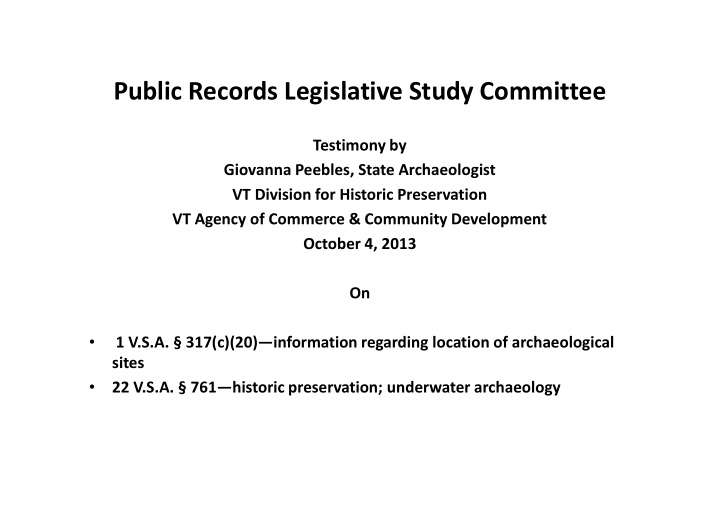



Public Records Legislative Study Committee Testimony by Giovanna Peebles, State Archaeologist VT Division for Historic Preservation VT Agency of Commerce & Community Development October 4, 2013 On 1 V.S.A. § 317(c)(20)—information regarding location of archaeological • sites 22 V.S.A. § 761—historic preservation; underwater archaeology •
Protecting Archaeological Site Locations 1 VSA § 317. Definitions; public agency; public records and documents (c) The following public records are exempt from public inspection and copying: (20) information which would reveal the location of archeological sites and underwater historic properties, except as provided in 22 V.S.A. § 762; [ this is an error – should say 761 , per below] 22 VSA § 761. State archeologist; survey; protection of archeological sites (b) All information regarding the location of archeological sites and underwater historic properties shall be confidential except that the state archeologist shall provide this information to qualified individuals or organizations, public agencies and nonprofit organizations for archeological and scientific research or for preservation and planning purposes when the state archeologist determines that the preservation of these properties is not endangered. (Added 1975, No. 109, § 4; amended 1989, No. 136 (Adj. Sess.), § 2; 1995, No. 46, § 45.)
Archaeological sites are about PEOPLE and unwritten stories of the past There are Many Types of Archeological Sites in Vermont – here’s just a few examples: • Pre-Contact and Post-Contact Native seasonal camps, villages, cemeteries & burial sites • African-American from early 19 th century – 20 th century: homesteads & farms, cemeteries • European period: • 18 th century military sites • Early homesteads • Abandoned hill farms & villages • Blast furnaces • Lime kilns • Extractive industries & related settlements: mines & quarries - copperas, copper, granite, marble, slate, • Shipwrecks
It’s about people! 12,900 - 9,000 years ago: Paleo- Indian hunters used spears, with atlatls, to very effectively take down caribou. 6,000 – 3,000 years ago: Preparing for winter included gathering hazelnuts and butternuts, and drying fish. Baskets were a critical item in Native life.
For most of history, people didn’t write and no one wrote about them. Contact period sites and early settlement archaeological sites reveal little known stories of Vermont’s past. 19th century, and even early 20 th century, archaeological sites supplement written records in unimaginable ways.
Archaeological sites contain artifacts that offer clues to the past, BUT…..
It’s the cultural deposits that contain the most clues… about diet, season, environment & climate, & patterns of people’s lives RT 78 Swanton project - - 7,000 years of Native settlements: Cultural deposit #101 at the Headquarters site in Swanton - - 2 clusters of fire cracked rock, and between them, a patch of fire altered soil infused with fish bone.
“I wish you could smell what we smell here in Swanton! This neat feature of heat altered soil and fire cracked rocks is chock full of tiny fish bones, feels very oily, and even smells of fish! Not bad for something that has been in the ground for about 4000 years.” Northeast Archaeology Research Center, RT 78 Project, Swanton. July 14, 2013
Location Map of East Creek (Orwell) Archaeological Sites Confidential Map- Removed
One of the hundreds of “arrowhead” collections from Vermont’s sites
Protecting Archaeological Site Locations 1 VSA § 317. Definitions; public agency; public records and documents (c) The following public records are exempt from public inspection and copying: (20) information which would reveal the location of archeological sites and underwater historic properties, except as provided in 22 V.S.A. § 762; [ this is an error – should say 761 , per below] Works well together with : 22 VSA § 761. State archeologist; survey; protection of archeological sites (b) All information regarding the location of archeological sites and underwater historic properties shall be confidential except that the state archeologist shall provide this information to qualified individuals or organizations, public agencies and nonprofit organizations for archeological and scientific research or for preservation and planning purposes when the state archeologist determines that the preservation of these properties is not endangered. (Added 1975, No. 109, § 4; amended 1989, No. 136 (Adj. Sess.), § 2; 1995, No. 46, § 45.)
Recommend
More recommend